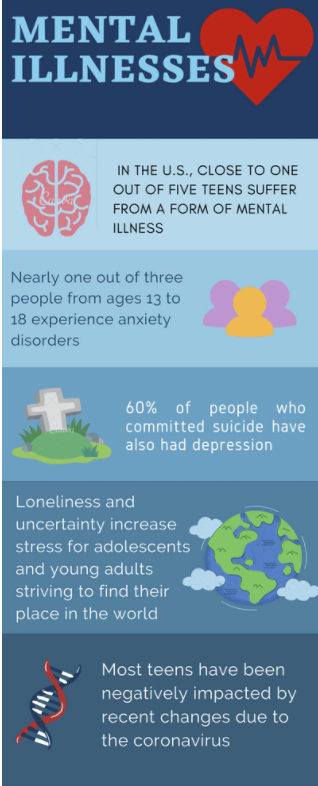Mental illnesses rising due to virtual learning
Close to one in five teens in the U.S., suffer from a form of mental illness, but only 4% of the annual Health Care budget is spent on mental health needs and resources, according to LiveScience. While there are different kinds of mental illnesses, the most common forms are anxiety and depression. With changes at school due to the coronavirus, these mental disorders can have a greater impact on students’ mental health.
Anxiety
A buildup of stressful situations throughout one’s life is known as anxiety. Causes of anxiety can range from the first day of school jitters to the fear of losing a job. The National Institute of Health states that though many may have experienced anxiety in some form, chronic anxiety, can lead to detrimental effects on one’s mental health and body and is considered to be more serious than regular anxiety.
“The problem with anxiety is that when it goes unchecked, it can become so severe that one is unable to do things they need to do,” psychology teacher Kristina Crawford said.
The CDC states with the new virtual format, spending long hours online completing coursework and without the in-person support from peers is a factor of having unrealistic expectations for today’s teens.
“For Chantilly students, unrealistic expectations can be especially difficult to reconcile. What we expect from ourselves or perceptions of what others expect of us, are the most difficult to overcome as those are unrealistic or simply misinterpreted,” Crawford said.
Social anxiety is the fear of being judged by others through nervousness in social situations. With the transition to online learning, it has allowed many students who face social anxiety to be at ease, however, some are self-conscious when turning on their mics and cameras.
“Kids are so anxious when in these situations and worry about how they will be perceived and judged by others to the point where they become paralyzed,” Crawford said.
Even with the virtual format, there are resources that can visit to help manage anxiety and create self-treatment mechanisms, such as Counseling.org, which discusses solutions such as what to do in a panic attack.
“It takes time and practice to develop coping strategies that work,” Crawford said. “Take time to understand what you need truly, and accept who you are. Know that you are ‘normal’ and there is nothing wrong with you.”
Stress
The central tension that causes anxiety for teens is stress. According to the American Psychological Association (APA), most teens from ages 13 to 17 have been negatively impacted by recent school changes due to the coronavirus. It can be hard to cope with being distanced from friends while dealing with online school.
“Online mental health issues have been rising and we don’t have our friends to fall back on,” junior Yukta Ramanan said. “We don’t have a personal relationship with our teachers, peers, or anyone at school, which makes it hard to cope.”
The APA states that loneliness and uncertainty about the future are very common sources of stress for adolescents and young adults striving to find their place in the world, and with the lurking danger of COVID-19, it is stressful for some to try to visualize their future due to having certain educational and external goals that cannot be fulfilled in an online environment.
Social interaction can be used as a method to reduce stress, but it can be difficult for some to be socially active when stuck at home. Young adults can possibly get social stress relief by indulging in hobbies that they enjoy, such as art, sports, helping the environment, school clubs and more, encouraging them to be the best version of themselves and much more according to Healthline.
Depression
The new lifestyle many developed due to the coronavirus has resulted in numerous detrimental effects on the mental health of students, like sadness and loneliness according to Boys&GirlsClub. This can lead to depression or depressive episodes.
“I feel like now with the lack of social interaction students are more likely to think negatively and become depressed,” sophomore Riley Frazier said.
Mood swings and low self-esteem are some of the many symptoms of depression. However, other illnesses can play a key role in the creation of depressive symptoms. For example, SuccessTMS states that OCD and depression often co-occur, so having this chronic illness increases the chance of depression. Addressing depression in its early stages is critical due to the possibility of it causing permanent brain damage by psychological factors and in rare cases physical changing of the brain shape.
“I feel like many kids our age don’t want to tell an adult or trusted one that they are depressed,” Frazier said. “This is probably because they feel embarrassed or hopeless.”
According to Counseling and psychological services at UC Santa Cruz, although depression is almost always temporary and can be cured, the mindset of suicide being the solution to getting rid of pain is very common. Verywellmind states that 60% of suicide victims had depression.
“School is like a getaway from reality for some students,” Frazier said. “Now that we’re stuck at home without seeing our friends every day, the environment could become lonely and unsafe.”
Your donation will support the student journalists of Chantilly High School. Your contribution will allow us to cover our printing and annual website hosting costs.

Gayatri Dhavala is a senior and the Business Manager of The Purple Tide. She enjoys talking about philosophy, writing spontaneously, eating at fancy restaurants...

Shreeja Tangutur is a senior and this is her third year on The Purple Tide. This year, she will be the Unity and Social Media Director for the publication....

Shreya Baskaran is a senior and the Sports Editor on The Purple Tide and this is her third year on the staff. She enjoys writing and reading. In her free...


